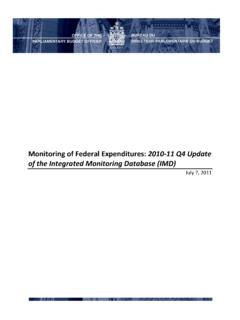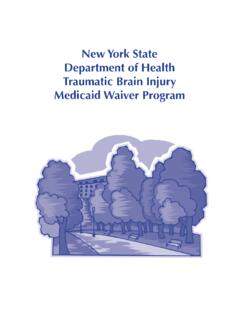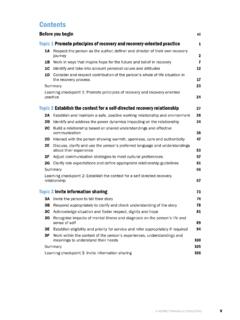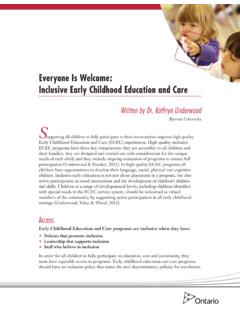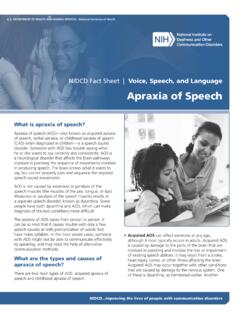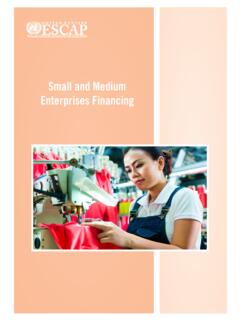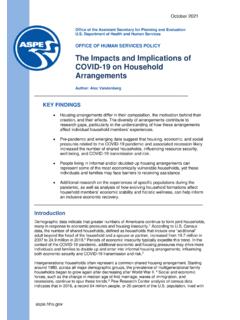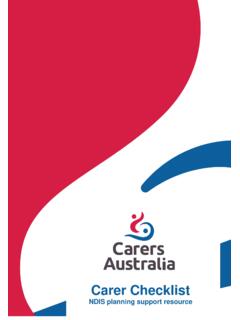Transcription of FIRST NATIONS CHILD WELFARE: COMPENSATION FOR …
1 April 02, 2020. FIRST NATIONS CHILD WELFARE: COMPENSATION FOR REMOVALS. Powered by TCPDF ( ). The Parliamentary Budget Officer (PBO) supports Parliament by providing economic and financial analysis for the purposes of raising the quality of parliamentary debate and promoting greater budget transparency and accountability. This report estimates the financial cost of complying with a Canadian Human Rights Tribunal decision (2019 CHRT 39) as it relates to FIRST NATIONS children taken into care. It was prepared at the request of Mr. Charlie Angus, Member of Parliament for Timmins-James Bay.
2 Some data used in this publication came from the FIRST NATIONS Component of the 2008 Canadian Incidence Study of Reported CHILD Abuse and Neglect (FNCIS 2008). These data were used with the permission of the FIRST NATIONS CHILD Welfare Research Committee. The study was funded by the federal, provincial, and territorial governments of Canada, the Social Sciences and Humanities Research Council of Canada, and the Canadian Foundation for Innovation. The PBO thanks the FIRST NATIONS CHILD and family Caring Society, the FIRST NATIONS CHILD Welfare Research Committee and Indigenous Services Canada for the information and explanations they provided to assist with this analysis.
3 The analyses and interpretations presented in this report are those of the PBO and do not necessarily reflect the opinions of the above mentioned organizations. For readability, all counts have been rounded to hundreds of persons. Lead Analyst: Ben Segel-Brown, Financial Analyst Contributors: Salma Mohamed Ahmed, Research Assistant This report was prepared under the direction of: Mark Mahabir, Director of Costing and General Counsel Nancy Beauchamp, Jocelyne Scrim, and R my Vanherweghem assisted with the preparation of the report for publication. For further information, please contact Yves Giroux Parliamentary Budget Officer RP-2021-001-M_e Table of Contents Executive Summary 1.
4 1. Introduction 2. 2. Cost of complying with the CHRT order 3. Placements by type 3. Placements outside family and community 4. Reason for removal 5. Necessity and prevention services 6. Parents 7. COMPENSATION 7. Differences in assumptions 8. 3. Comparative cost of settling a class action 12. Appendix A Possible interpretations of further restrictions 14. Notes 20. FIRST NATIONS CHILD Welfare: COMPENSATION for Removals Executive Summary In September 2019, the Canadian Human Rights Tribunal (CHRT) ordered Canada to pay COMPENSATION to FIRST NATIONS children and caregivers who were affected by the on-reserve CHILD welfare system.
5 The Government of Canada has applied for judicial review of the CHRT. decision, which could result in the COMPENSATION order being dramatically narrowed or voided entirely. This report estimates the cost of complying with the decision as it relates to children taken into care. The preliminary estimate of Indigenous Services Canada (ISC) was that 125,600 people are eligible for COMPENSATION totalling $ billion. Based on the PBO's assumed legal interpretation, the PBO estimates that 19,000 to 65,100 people are eligible for COMPENSATION in a range of $ billion to $ billion.
6 Both estimates assume COMPENSATION is paid by the end of 2020. Summary Table 1 High-level comparison of estimates ISC PBO. # Eligible 125,600 19,000 to 65,100. Cost to compensate $ $ to $ ($ billions). The PBO expects fewer people to be eligible primarily because we assume that children placed within their extended family or community are not eligible for COMPENSATION . Our estimate is presented as a range, as it is unclear what proportion of children will be excluded, either because the CHRT deems that their removal was necessary, or that their family benefited from prevention services.
7 This report examines a number of scenarios under which these two eligibility criteria might be applied, and their possible impact on eligibility for COMPENSATION . The Government of Canada has indicated that it intends to compensate those harmed by removals through the settlement of a class action. There may be significant barriers to a successful class action, which could result in fewer families receiving COMPENSATION . In addition, COMPENSATION for each removed CHILD would not necessarily be more than the amount awarded by the CHRT. 1. FIRST NATIONS CHILD Welfare: COMPENSATION for Removals 1.
8 Introduction In September 2019, the Canadian Human Rights Tribunal (CHRT) ordered Canada to pay COMPENSATION to certain FIRST NATIONS children and caregivers who were harmed by racial discrimination in federal funding for CHILD and family services on-reserve and in Yukon. 1. The decision included orders of COMPENSATION related to the removal of children from their family and related to delays and denials of essential services to children. This report focuses solely on COMPENSATION for removals. It includes COMPENSATION for removals to receive services but excludes COMPENSATION for delays and denials of services to children who remained in their homes.
9 The preliminary estimate of Indigenous Services Canada (ISC) was that 125,600 people are eligible for COMPENSATION totalling $ billion, including interest. Based on the PBO's assumed legal interpretation, we estimate that 19,000 to 65,100 individuals are eligible for COMPENSATION that would range from $ billion to $ billion, including interest. The PBO assumes that the CHRT decision requires Canada to pay $40,000 to all FIRST NATIONS children ordinarily resident on-reserve or in Yukon at the time of their removal who were: 1. Unnecessarily removed from their home, family , and community after 1 January 2006 due to poverty, poor housing, neglect, or substance abuse and did not benefit from prevention services that would have permitted them to remain safely in their home, family and community.
10 2. Removed from their homes after 1 January 2006 due to abuse and placed outside their family and community; or 3. Were deprived of essential services within the scope of Jordan's Principle 2 and placed in care outside their homes, families and communities in order to receive those services between 12. December 2007 and 2 November 2017. For each eligible CHILD removed for reasons other than abuse, the parent(s) or grandparents of that removed CHILD are also entitled to $40,000 in COMPENSATION . 3. All the major parties to the CHRT proceedings have varying legal interpretations that differ from each other and from the PBO's assumptions set out above.
